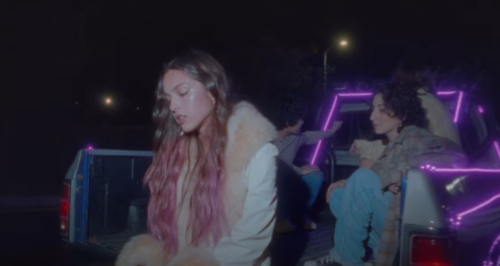It would be easy to say that “teenhood” never changes, therefore the experience might look similar throughout the decades. And yet, there’s no denying that what Olivia Rodrigo presents as “being a teenager” is a more stylized, romanticized version of it. One that hasn’t existed quite so intensely since, well, the 90s. The very decade Rodrigo seems to be doing an unwitting sendup of in her latest video and single from Sour, “traitor.”
Apart from also borrowing from the Lana Del Rey shtick of vintage-ifying the cinematography, Rodrigo noticeably seems to have watched the Smashing Pumpkins’ “1979” before coming up with the concept for this narrative (it wouldn’t be out of the realm of possibility considering her Alanis connection/recently appearing on the cover of Rolling Stone with her). One that focuses, again, on her bread-and-butter brand of “being a teen” (and yes, she should definitely milk that as much as possible before the dreaded twenty that her lone peer, Billie Eilish, is about to be faced with). Despite being done with high school, Rodrigo isn’t done with delineating the shenanigans that arise from a combination of youthful folly, ennui and rage. But, try as she might, “1979,” released in 1996, remains perhaps the ultimate beacon of representing that.
Although its themes endure on a timeless level, it is still the zenith of mid-90s, Gen X apathy. Of the very kind that was patented under the umbrella term of “grunge” thanks to Nirvana. And, speaking of, one tends to wonder if Rodrigo might be using the very same pool that the band did for their immortal (and now highly contentious) Nevermind album cover. Because, yes, obviously, in grand homage to 90s and 00s-style mischief, Rodrigo and her friends jump into a pool after hours (though somehow in a manner that doesn’t come across as law-breaking as how the crew from the original Gossip Girl did it).
The underwater sequences in “traitor” bear particular stylistic “grainy VHS” similarity to another 90s video staple, Duran Duran’s “Come Undone,” as well as Lana Del Rey’s “Music To Watch Boys To.” Rodrigo’s “California vibe” is also present via her perch in the back of a truck bed for certain portions of the storyline, something Del Rey was also fond of wielding in the “Bartender” segment of the “Norman Fucking Rockwell” video trilogy. But, in Rodrigo’s defense, she’s actually from CA, whereas Del Rey is but a transplant who has managed to commodify it as well as Angelyne. What’s more, Rodrigo has been able to encapsulate the pains of youth from a different, less baroque pop approach, instead going for a more “rock” tinge (you know, “rock” like Miley Cyrus-style). Something the Smashing Pumpkins could actually ally themselves with as a genre.
Capturing the disaffection of adolescence in a way that no band has been able to as effectively before or since, the “1979” video was also shot in California, even if Billy Corgan wanted it to pass for “the suburbs of Chicago” (that’s the thing about suburbs—they’re so interchangeable). Giving us the distinct sense that “cool kids never have the time” (yet, alternately, have so much of it to spare) the video follows a group that drives around aimlessly in a 1972 Dodge Charger (in Rodrigo’s video, it’s a Dodge Ram), doing donuts occasionally in between.
Eventually, they pull over, get out of the car and run into the mountains overlooking the entire sprawl so that the ringleader can flip off the whole town. Rodrigo, still being tied to Disney, can’t quite go that “buck wild” with such a gesture. By nightfall, the group is at a party where the Smashing Pumpkins play the role of “house band.” At one point, the ringleader goes into the bathroom to piss, finding a couple making out in the shower, which, of course, prompts him to turn the water on to hose them off. The aimless recklessness continues when he and his friends mount the wall of a nearby yard and jump into the pool as Corgan sings, “We don’t even care, as restless as we are.” The same goes for a broken-hearted Rodrigo, whose friends jump in the Olympic-sized pool behind her before she does.
Unlike Rodrigo’s posse, the one in “1979” has a greater predilection toward vandalism, tossing any random outdoor furniture they can get their hands on into the pool before they move on to tee-peeing a house (that’s what’s really missing from Rodrigo’s attempt at 90s nostalgia/overall teenage glorification). Their anti-authority ways continue when they hit up a convenience store and start arbitrarily trashing it as well. Rodrigo, of course, hangs with a group that’s much tamer than that, and maybe the thing we’re not acknowledging here is that one has to be tame when they’re not white. Otherwise, their chances of being met with the long arm of the law are far greater. And while the police do show up in “1979,” we don’t actually see anyone get arrested. The same likely wouldn’t be true for Rodrigo and her multi-ethnic crew (and yes, she represents diversity in a fashion that comes across more genuinely than what Billie Eilish did in the “Lost Cause” video).
Rodrigo’s gang prefers to round out their night by entering an arcade space, where quaint games like pool, air hockey and the teddy picker are offered. Although the arcade setting doesn’t appear in “1979,” the album artwork for the single features the band in front of a “Game Room”/“Party Room.” Just one of the numerous ways in which the parallels between “traitor” and “1979” are unignorable, and yet, maybe Rodrigo had no idea. The lack of newness in pop culture being a direct product of the tenets required by capitalism. This, too, being manifest in Rodrigo’s video for “brutal.” So while she might “do” suburban teen angst well enough, it’s already been bottled more authentically by “1979.”




















